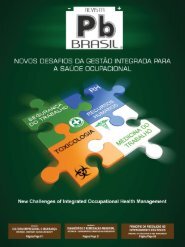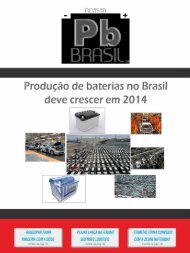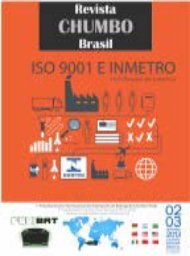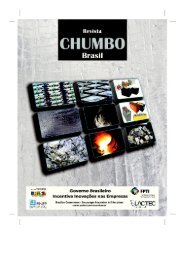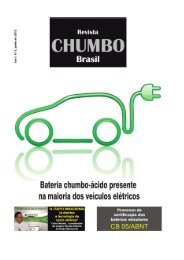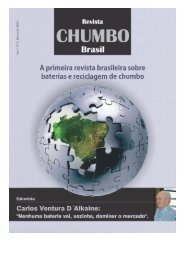edição 7
Esta edição marca a primeira etapa da Fenibat. Os espaços foram vendidos, organização do evento está toda definida e concretizada. No site estão disponíveis todas relativas a este evento inclusive as palestras e mesa redonda. Também teremos como matérias variadas sobre o tema da revista.
Esta edição marca a primeira etapa da Fenibat. Os espaços foram vendidos, organização do evento está toda definida e concretizada. No site estão disponíveis todas relativas a este evento inclusive as palestras e mesa redonda. Também teremos como matérias variadas sobre o tema da revista.
Create successful ePaper yourself
Turn your PDF publications into a flip-book with our unique Google optimized e-Paper software.
INMETRO<br />
Nosso laboratório nunca participou de alguma<br />
outra certificação. Este laboratório nasceu junto<br />
com o projeto de certificação das baterias automotivas<br />
há aproximadamente 04 anos atrás e apesar<br />
de ainda não ter recebido a acreditação do Inmetro<br />
para com a norma ABNT NBR 17025, nós somos:<br />
i) autorizados pelo Inmetro desde 2010 a realizar<br />
todos os ensaios para Programa Brasileiro de<br />
Etiquetagem – PEB, para as baterias utilizadas nos<br />
sistemas de energia foltovoltáica.<br />
ii) autorizados por 04 Organismos de Certificação<br />
de Produtos – OCPs a realizar todos os ensaios<br />
exigidos na Portaria INMETRO n° 299/2011<br />
que rege os ensaios de certificações de baterias automotivas,<br />
execto os ensaios químicos.<br />
3 – Qual a sua sugestão aos fabricantes para os<br />
ensaios de manutenção?<br />
Nossa sugestão aos fabricantes/importadores<br />
para os ensaios de certificação e manutenção são:<br />
i) Conhecer cuidadosamente as quatros portarias<br />
(e seus anexos): Portaria INMETRO n°301/2011,<br />
Portaria INMETRO n°361/2011, Portaria INME-<br />
TRO n° 239/2012 e Portaria Inmetro n°299/2012.<br />
O conhecimento destes documentos permitirão<br />
aos fabricantes entender as “regras do jogo” às<br />
quais seus produtos estão sendo submetidos.<br />
ii) Conhecer com a máxima acuidade os parâmetros<br />
elétricos declarados nos rótulos das baterias,<br />
em especial se detendo quanto à reprodutibilidade<br />
dos lotes. Este conhecimento passa, no<br />
mínimo, pelo controle da uniformidade de quatros<br />
principais etapas do processo de produção: característica<br />
do pó de partida, controle da produção<br />
das massas positivas e negativas (materiais precursores),<br />
controle da cura e controle da etapa de<br />
formação, neste caso, desde as características da<br />
solução de ácido sulfúrico utilizada até o regime<br />
de formação adotado. O mais importante, na atual<br />
etapa de certificação, nem mesmo é a qualidade de<br />
todos estes processos, mas seus controles uniformes<br />
para manter as características elétricas homogêneas<br />
dentro dos váris lotes produzidos.<br />
iii) Conhecer e informar ao laboratório que irá<br />
realizar os ensaios de certificação, a melhor forma<br />
(algoritmo) de levar a bateria à plena carga já<br />
que os ensaios são realizados de forma sequencial<br />
e na mesma amostra. Desta forma é importante<br />
determinar, quando necessário, a forma da plena<br />
ii) Authorized by four product certification<br />
organisms (PCO) to make every test required by<br />
the INMETRO’s ordinance nº 299/ 2011 that rules<br />
the tests of automotive batteries certification,<br />
except the chemical tests.<br />
3 – Which is your suggestion to manufacturers<br />
for the maintenance tests?<br />
Our suggestion to manufacturers/ importers<br />
for certification and maintenance tests are:<br />
i) To know carefully the four ordinances (and<br />
their attachments): INMETRO’s Ordinance nº<br />
301/2011, 361/2011, 239/2012 and 299/2012.<br />
The knowing of these documents allows the manufacturers<br />
to understand the “game’s rules” to<br />
which their products are being submitted to.<br />
ii) To know with the maximum acuity the electrical<br />
parameters declared in the batteries’ labels,<br />
with special attention to the batch reproducibility.<br />
This knowing pass, at minimum, through the uniformity<br />
control of four main steps of the production<br />
process: characteristics of the starting lead<br />
oxide, production control of positive and negative<br />
paster (precursor materials), curing and formation<br />
step control, in this case, from the characteristics<br />
of the sulfuric acid used to the adopted formation<br />
regime. The most important, in the formation step,<br />
is not even the quality of all this process, but its<br />
uniform control to maintain the electrical characteristics<br />
consistent amongst the many lots produced.<br />
iii) To know and inform the lab that will make<br />
the certification tests the best way (algorithm) to<br />
bring the battery to full charge, since the tests are<br />
made sequentially and in the same sample. Thus,<br />
it is important to determine, when necessary, the<br />
configuration of full charge to equalize the battery<br />
(when the battery gets to the lab), the configuration<br />
of full charge after relatively deep discharge<br />
tests, such as capacity tests and the configuration<br />
of full charge after superficial discharge tests, for<br />
example, the cold cranking tests (CCA). For the<br />
case they are not known, the algorithms used are<br />
those suggested in the Brazilian standards, NBR<br />
15940:2011 and NBR 15941:2012, or in the inter-<br />
Chumbo Brasil 24






